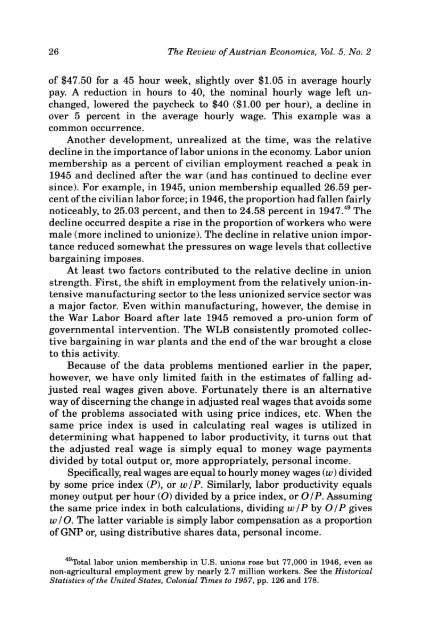Review of Austrian Economics - The Ludwig von Mises Institute
Review of Austrian Economics - The Ludwig von Mises Institute
Review of Austrian Economics - The Ludwig von Mises Institute
Create successful ePaper yourself
Turn your PDF publications into a flip-book with our unique Google optimized e-Paper software.
26 <strong>The</strong> <strong>Review</strong> <strong>of</strong> <strong>Austrian</strong> <strong>Economics</strong>, Vol. 5, No. 2<br />
<strong>of</strong> $47.50 for a 45 hour week, slightly over $1.05 in average hourly<br />
pay. A reduction in hours to 40, the nominal hourly wage left unchanged,<br />
lowered the paycheck to $40 ($1.00 per hour), a decline in<br />
over 5 percent in the average hourly wage. This example was a<br />
common occurrence.<br />
Another development, unrealized at the time, was the relative<br />
decline in the importance <strong>of</strong> labor unions in the economy. Labor union<br />
membership as a percent <strong>of</strong> civilian employment reached a peak in<br />
1945 and declined after the war (and has continued to decline ever<br />
since). For example, in 1945, union membership equalled 26.59 percent<br />
<strong>of</strong> the civilian labor force; in 1946, the proportion had fallen fairly<br />
noticeably, to 25.03 percent, and then to 24.58 percent in 1947. 49 <strong>The</strong><br />
decline occurred despite a rise in the proportion <strong>of</strong> workers who were<br />
male (more inclined to unionize). <strong>The</strong> decline in relative union importance<br />
reduced somewhat the pressures on wage levels that collective<br />
bargaining imposes.<br />
At least two factors contributed to the relative decline in union<br />
strength. First, the shift in employment from the relatively union-intensive<br />
manufacturing sector to the less unionized service sector was<br />
a major factor. Even within manufacturing, however, the demise in<br />
the War Labor Board after late 1945 removed a pro-union form <strong>of</strong><br />
governmental intervention. <strong>The</strong> WLB consistently promoted collective<br />
bargaining in war plants and the end <strong>of</strong> the war brought a close<br />
to this activity.<br />
Because <strong>of</strong> the data problems mentioned earlier in the paper,<br />
however, we have only limited faith in the estimates <strong>of</strong> falling adjusted<br />
real wages given above. Fortunately there is an alternative<br />
way <strong>of</strong> discerning the change in adjusted real wages that avoids some<br />
<strong>of</strong> the problems associated with using price indices, etc. When the<br />
same price index is used in calculating real wages is utilized in<br />
determining what happened to labor productivity, it turns out that<br />
the adjusted real wage is simply equal to money wage payments<br />
divided by total output or, more appropriately, personal income.<br />
Specifically, real wages are equal to hourly money wages (w) divided<br />
by some price index (P), or w IP. Similarly, labor productivity equals<br />
money output per hour (O) divided by a price index, or 01 P. Assuming<br />
the same price index in both calculations, dividing w/P by O/P gives<br />
w/O. <strong>The</strong> latter variable is simply labor compensation as a proportion<br />
<strong>of</strong> GNP or, using distributive shares data, personal income.<br />
Total labor union membership in U.S. unions rose but 77,000 in 1946, even as<br />
non-agricultural employment grew by nearly 2.7 million workers. See the Historical<br />
Statistics <strong>of</strong> the United States, Colonial Times to 1957, pp. 126 and 178.

















